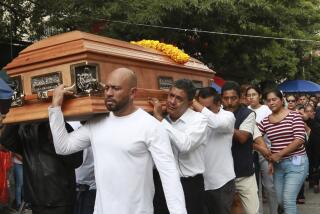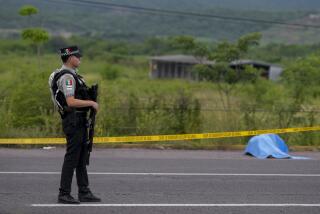Armed Workers Hit : Nicaragua War Blurs Civilian, Military Roles
- Share via
NUEVA GUINEA, Nicaragua — Juan Antonio Diaz, a 28-year-old lumberjack in Nicaragua’s war zone, goes to work each day with a chain saw in one hand and an AK-47 assault rifle in the other.
Eight times in his four years at the state-owned Carlos Fonseca Forestry Co., he has used the rifle to fight off attacks by U.S.-backed contras in the mountains where he works.
This week, Diaz was slightly wounded in a rebel ambush that killed eight company workers as their pickup truck rounded a curve on the slopes of Hell’s Peak in southeastern Nicaragua.
Identities Blurred
The Sandinista government listed them as civilian victims of a rebel “terrorist attack.” But the fact that all 10 lumberjacks in the truck carried rifles, and some wore olive drab uniforms, shows how the five-year-old war has blurred civilian and military identities.
Defense Minister Humberto Ortega said late last year that the army had trained and equipped 300,000 Nicaraguans for military defense and expected “very soon” to arm 200,000 more.
Even if the figures are exaggerated, as some diplomats suspect, they are an indication of how heavily the regular army, estimated to number around 70,000 troops, relies on militiamen, reservists and loyal peasant farmers to defend the country as the war intensifies.
Armed Workers
In and around frontier towns like Nueva Guinea, population 12,000, it is common to see armed men in olive-colored uniforms working in state companies or harvesting crops on government-run cooperative farms.
Some wear uniforms kept after army duty as two-year conscripts. Others, like the lumberjacks, are issued army-style uniforms by their employers as optional work clothes.
The ambiguity over who is who in the war effort is reflected in a sign at Hilda’s Restaurant and Bar, on a hot, dusty central street here. It says: “No liquor sold to soldiers, men in uniform or those with weapons.”
As far as the contras are concerned, such distinctions are meaningless.
‘Military Outposts’
Adolfo Calero, a leading rebel figure, once said his guerrillas attack cooperatives guarded by farmer-militiamen because they are, essentially, “military outposts,” even though unarmed civilians often die in such raids. Some rebel spokesmen define any truck carrying an armed Sandinista as a military vehicle.
Diaz said that in this week’s attack, which occurred Wednesday, he and five other workers in the lumber truck fired back at their 15 to 20 assailants in a brief losing battle.
The lumber company, named for the late Carlos Fonseca Amador, one of the founders of the ruling Sandinista National Liberation Front, has reported 32 of its workers killed in rebel ambushes over the past three years. It now has about 120 employees, and all are trained by co-workers to use weapons provided by the army, company officials said.
‘Revolution’s Martyrs’
At local headquarters of the Sandinista Front, a wall poster listing the names of this week’s victims hailed them as “martyrs of the revolution.”
As they buried the dead Thursday, lumber workers here debated the wisdom of arming themselves. Most agreed it was still safer to look like soldiers.
“We are civilian workers, but we have to defend ourselves and the welfare of our children,” said Diaz, nursing a shrapnel wound on his left temple. “We are targets of aggression. We never know when they’re going to attack.”
Laureano Limas Vargas, 19, the other survivor of the ambush, said he thinks that the contras might have shot at the truck simply because the occupants were armed.
He said the rebels took rifles and ammunition from the dead workers.
Guerrillas’ Aim
But Wilfredo Barreto, the top Sandinista official in Nueva Guinea, said the rebels’ aim is to disrupt productive state enterprises, not to attack military targets.
“The contras know these are workers on an important economic project,” he said.
In other areas attacked by the rebels, the distribution of arms by the Sandinistas has divided the local populace.
Last year, when the army set up a volunteer militia to protect 82 families of the Monterrey coffee farming cooperative in northern Nicaragua, 15 men agreed to join it.
The contras raided the place this month in a search for weapons and were driven off by the militia in a 2 1/2-hour fight. But several men later quit the force and gave their rifles back to the army, saying they feared being singled out in future raids.
“Unless everybody here is willing to take up arms, we cannot keep defending ourselves,” said Catalino Gonzalez, one of the ex-militiamen.
Clandestine Collaborators
While the Sandinistas rely on local militias, the contras tap a clandestine network of collaborators among rural peasants for information on how to elude army patrols and strike government targets.
In the cattle region around Nueva Guinea, about 70% of the 113,000 residents live in widely scattered hamlets where the Sandinistas have been slow to organize, Barreto said.
Relatives of some of the dead lumber workers said the area is so infiltrated with rebels and rebel supporters that it is unsafe to go into the mountains, with or without arms.
“My husband heard there were 600 contras in the area and was against going out with so few men, but they told him to go work anyway,” said Nimia Vaez, 32, weeping and clutching her 18-month-old son. Her husband, Rodrigo Gurdian, 45, died in the ambush.
More to Read
Sign up for Essential California
The most important California stories and recommendations in your inbox every morning.
You may occasionally receive promotional content from the Los Angeles Times.










